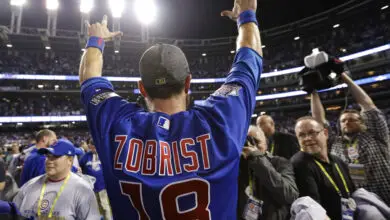
Can You Name Which Cubs Are Best at Catching and Throwing and Stuff?
The Cubs have (arguably) the best pitching staff in baseball and they’ve got a lineup stacked with dangerous hitters, but it’s their defense that’s really setting them apart this season. And they’re not out there auditioning for the redux of a stodgy, Tom Emanski-approved fundamental video, either. No, these guys are mixing in all kinds of flare as they flash the leather, whether it’s snagging short hops or executing perfect relays.
Javy Baez has already done enough to merit his own defensive highlight reel while playing at three different infield positions (I’m not really going to count first base). Even his tags are worthy of a hype video. But he’s not the best glove man, at least in terms of the metrics, on a team filled with phenoms.
First things first, there’s a lot of noise in defensive metrics and given the calculations and sample sizes involved, it’s usually necessary to look at more than a single season to measure a players true value. That said, I still want to review the Cubs stats as expressed by FanGraphs’ catch-all Def metric. Is it perfect? No. But it’s fun, and fun is good.
[beautifulquote align=”left”]The Cubs employ two individual players who’d rank 12th and 14th as teams.[/beautifulquote]According to FG, only 12 teams have an aggregate Def greater than 12.1 and only five teams are over 40. The Giants are currently in second place with a 61.5, nearly 11 points above the Dodgers (50.7). The Cubs have run away from the field, posting a 77.9 and employing two individual players who’d rank 12th and 14th as teams. Think you can name them?
Better yet, can you name the rest of the Cubs regulars based on their aggregate defensive metrics? Below, I’ve anonymously listed the individual Def tallies for 15 position players, all but one of whom are on the 25-man roster at this point. Take a few moments to see how many you can name. I can almost guarantee you won’t get them all without help, which I’ll kinda-sorta provide if you scroll down.
Because these are cumulative, you’ll generally see the highest totals from players who log the most innings. That’s not always the case though, as a superior glove can put up some big numbers in a hurry. That said, I wanted to standardize the performance by looking at the players’ Def per 100 innings. The good is still good and the bad* is still bad, just to varying degrees.
Does looking at it from a different angle help you to solidify your choices? Did it change anything? Once you’ve got your field set or are either too exasperated or unwilling to assign all the names, check out the answer key to see how you did. Comment below or tweet me to let me with your results, which are undoubtedly better than mine would have been.
Something to keep in mind about these metrics is that they can’t necessarily be used to argue for more or less playing time for an individual. There’s enough wiggle room involved in their calculation that any definitive conclusions you draw will be based on shaky foundations. While the larger sample sizes obviously provide for more solid ground, there’s something about these numbers and how this particular team generates them that is a bit unique.
I’m speaking, of course, of the frequent positional movement by pretty much everyone on the roster. Of the 15 players listed above, only four (by quick count) have been limited to a single spot on the field. While most of these guys have acquitted themselves quite well, one can reasonable assume that a more static defensive alignment would yield better results from the regulars. Or maybe not Maybe all the moving around keeps them fresh and focused.
There’s great value in being able to prevent runs in more than one spot, even when we’re talking about a guy who might not be able to hit a fastball. Or a guy who got sent down to the minors the day after his wedding. Then there are those to whom you grant some extra allowance because of what they can do with the bat, hitters who you merely tolerate in the field. Good thing for the Cubs, they don’t have too many in the latter category.
To whatever extent you buy into the veracity of the numbers themselves, the main takeaway here is that the Cubs are very good at catching and throwing baseballs. That should help tremendously when they get to a point where runs will be at more of a premium. Well, unless players L and N are getting a lot of time in the field in October. But since that would necessitate one of those players actually rejoining the team, I’m not sure it’ll matter.
Now get to work on this little Sudoku puzzle and let me know how you did.
*Inasmuch as you consider some of these guys bad. Different weights for different positions are going to skew things as well, so keep that in mind.



